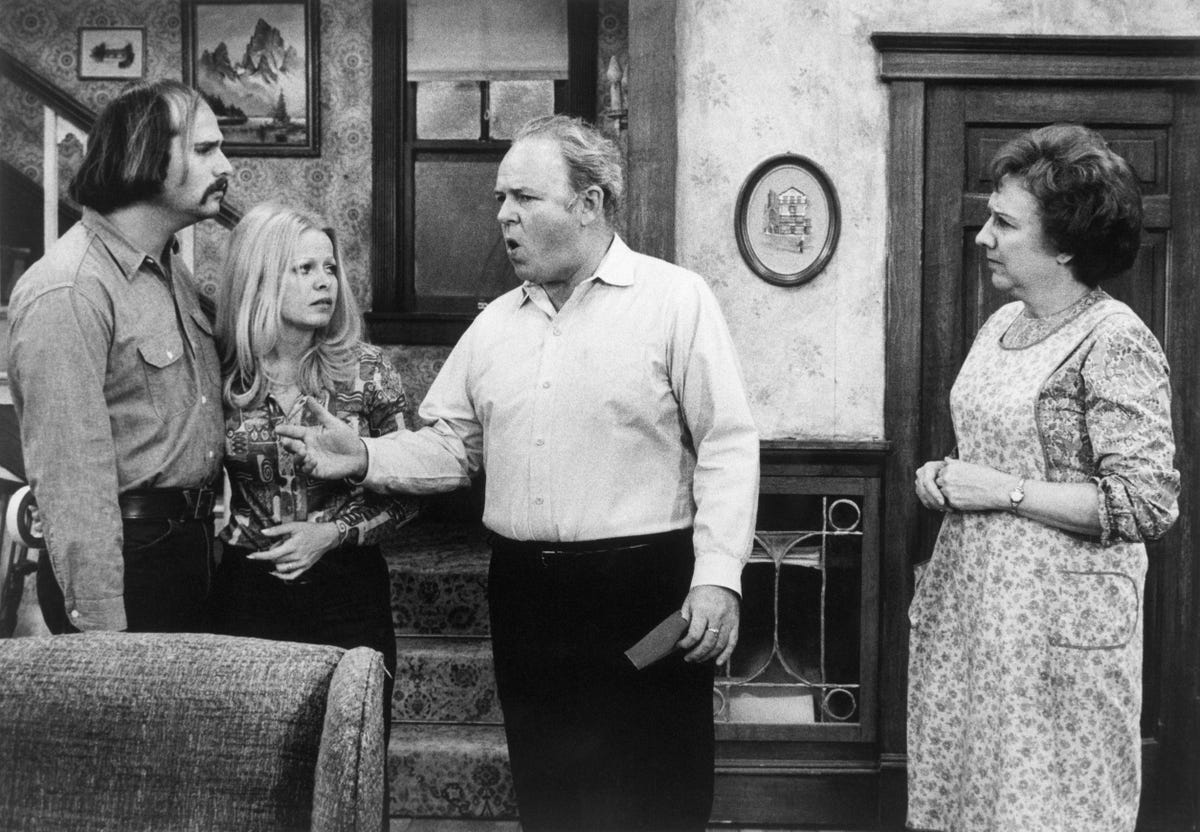
(Original Caption) (Left to right): Rob Reiner, Sally Struthers, Carol O’Connor, and Jean Stapleton … [+]
Treasures found in dusty boxes not opened for nearly half a century provided Jim Colucci with not only much needed research for his latest project, but a personal thrill as well.
Colucci is the c0-author of All in the Family: The Show that Changed Television. Written with the creator of the series, TV icon Norman Lear, the book contains a forward by late-night talk show host Jimmy Kimmel.
When he was approached about researching and writing the book, Colucci was already deep in another project. But, he was all too happy to put that endeavor on the back burner to forge ahead with the book, explaining, “When you’re asked if you want to collaborate with a 98-year-old legend like Norman Lear, talking about his ground-breaking show that changed comedy forever, the answer is always ‘yes! Absolutely!’”
As the author of The New York Times Bestseller Golden Girls Forever: An Unauthorized Look Behind the Lanai as well as Will & Grace: Fabulously Uncensored, Colucci knows a thing or two about delving into the history of a television series.
“All in the Family: The Show That Changed Television.”
All in the Family, which debuted in 1971 on CBS, featured Archie Bunker, a working-class argumentative bigot who isn’t shy about voicing his opinions about virtually every topic. Edith, his sweet, albeit somewhat-dimwitted wife, lives in a sort of conjured bliss, but she never misses an opportunity to zing Archie about his often ridiculous steadfast beliefs.
Recommended For You
The couple resided in an average house with their daughter Gloria and her Polish unemployed, yet progressive, husband Mike, who Archie, in his own affectionate way, calls ‘Meathead.’ Archie’s dilemma is that he constantly finds himself surrounded by people he disdains – his Black neighbors, Edith’s feminist cousin Maude, and his drinking buddies at the local tavern who are Jewish, among others.
With over 200 episodes produced, Colucci knew that it would be impossible to highlight each one, besides, he asserts, there are plenty of episode guides available that contain information about the storylines. Instead, the team felt it was more important to talk about the episodes that illustrate how the show was put together and those that stand out for various creative reasons.
So, the goal became, as Colucci says, “to pick the best loved episodes, but also the episodes that you may not know were pivotal because something happened behind the scenes.”
He says that because it’s the 50th anniversary of the debut of the series, “We felt it was appropriate to feature 50 episodes,” with Lear sharing his take on those that exemplify why the show remains constantly funny and relevant, no matter what the year.
With this in mind, Colucci originally set out to watch those particular episodes, but he actually ended up watching every single installment of the half-hour comedy.
When it came to speaking with Lear, Colucci confesses that he was more than a bit excited. “I thought, ‘you mean I get to sit and talk to Norman Lear and ask him everything I’ve ever wanted to ask him?’ Yeah, ok, I’m in for that.”
Working together during the pandemic, Colucci and Lear connected via Zoom for what Colucci says were several meetings totaling about eight or nine hours.
Author and TV Historian Jim Colucci.
Additionally, Colucci spoke with approximately 60 other people connected to the series, including actors including Sally Struthers (Gloria) and Rob Reiner (Mike ‘Meathead’ Stivic), as well as writers, producers, directors, crew members, showrunners of other series who admire Lear, and experts on topics including rape treatment and global warming which were featured in episodes of the series.
However, the book contains more than just those conversations – it’s full of pictures, notes, and other graphic treasures.
This is where those dusty boxes come in.
“I knew that to make it as visual as possible, to find good photos, well, you can go to the CBS photo library or to a stock image place, but we didn’t want just photos, we wanted documents, letters, scribbled notations, and things like that,” explains Colucci.
Then, he says, Lear’s team popped up and said, “Well, we have some boxes that we have basically filed away off-site and nobody’s opened in about 50 years. So, do you want to come over to Norman’s house and dig through those?”
Without a moment’s hesitation, Colucci jumped at the offering. He says that he felt like a kid in a candy store as he went through the 35 boxes while sitting in Lear’s abode.
Page from “All in the Family: The Show That Changed Television’ showing behind the scenes pictures … [+]
While Colucci uncovered plenty of pearls stashed in those containers, he says that one of the things that really surprised him was finding out that Lear is a bit modest about some of his achievements.
He explains with an example, saying, “There was an episode and in it Gloria and Mike are fighting over the environment. Mike points out that aerosol cans are burning a hole in the ozone layer. Now remember, this was back in the days when there were only three networks so a lot of people saw that episode and the message in it got through so loud and clear that it really was the jumping off point for people not wanting to use aerosols anymore.”
That episode had far reaching effects, says Colucci. “I found out that there was a documentary about the ozone problem – how we have averted a planetary disaster. I talked to one of the scientists who made that documentary and he said, ‘Norman Lear saved the planet by putting the problem on TV, on a show that millions of people were watching. Had aerosols continued being used the way they were, life on Earth would have ended by 2010.’ You hear that and you just have to say, ‘Wow,’ but Norman is really so humble about things like this.”
Another thing that surprised Colucci was the confidence Lear had in the show from its earliest moments.
Norman Lear, executive producer of the Pop TV series “One Day at a Time,” poses for a portrait … [+]
Lear’s faith in the series showed in the topics he tried to tackle, right from the beginning, explains Colucci. “Most fledgling shows are just trying to make their case for staying on the air through their first 13 episodes and beyond. When I asked Norman, ’weren’t you afraid of bucking the whole system and getting canceled by having episodes about controversial topics such as racism, Archie’s friend being gay, and having a cross-dressing character’ – none of which was shown on TV at the time – he responded by saying that they wanted to find things about human behavior that were real and show that no matter what others thought. Most producers would play nice in the beginning and not rock the boat, but Norman, for some reason, just always went for what he wanted.”
This isn’t to say that the network had the same level of certainty that All in the Family would succeed. “They did things like when they were picking furnishings for the set, they picked things that were cheap. I mean, they wanted everything to look well-worn because that’s what the show called for, but, for example, when they bought those iconic chairs that Archie and Edith sit in, there was no thought about posterity for those. They got them in a thrift shop for like five or 10 bucks and the irony is that later they had to reproduce them at a huge cost because that fabric hadn’t been made in decades.”
And viewers weren’t sure about the series at the start either. Their initial feelings about it were clearly mixed, says Colucci. “The network got letters that said, ‘Why are you giving your time to a bigot? Why are you legitimizing his point of view?’”
But Lear had a great retort, says Colucci. “His argument was ‘we’re satirizing this point of view.’”
Colucci says that this is a tough tightrope to walk and that All in the Family accomplished something very unique in that, unlike most things today, it appealed to, and continues to appeal to, both the right and left leaning viewers.
This was accomplished by using the best writers, an amazing quartet of actors, and showing different points of view, says Colucci, adding, “It’ll really reminds you, maybe of your own conflict with your parents or your own conflict with somebody else with a different point of view. It’s very realistic and perfectly executed. And, it does all of this while making you laugh. That’s an amazing feat.”
For younger viewers, who may not be familiar with the series and question its relevancy in the television landscape, Colucci explains, “People really need to realize that TV was not always like it is now. There are so many platforms for different points of view, different types of language, different levels of sexuality and violence. There’s so much choice now. Back in the day, when this show was on, TV watchers had only three choices and those three choices were all broadcasters, meaning they had to appeal to everybody and not offend anybody. So, for this show, and the way it pushed the boundaries, it was really extraordinary at that time.”
He goes on to say, “Prior to All in the Family, the biggest problem shown on a sit-com was, ‘Oh, no, the boss is coming over and the wife has burnt the roast,’ or something like that. What Norman Lear did was to have faith that America could handle more important topics. And he used humor to really talk about things that matter. It was truly a fulcrum that changed everything and paved the way for all of the content we enjoy today.”
‘All in the Family: The Show that Changed Television’ is available now through online and local booksellers, as are ‘Golden Girls Forever: An Unauthorized Look Behind the Lanai’ and ‘Will & Grace: Fabulously Uncensored.’







